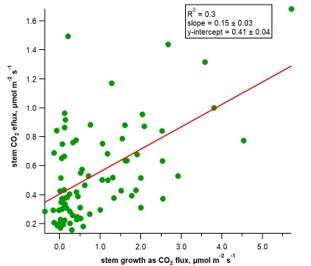Stem respiration and growth in the Tropics.
The Science
Current models predict that autotrophic respiration increases with growth rates and temperature. We found that when averaged over the annual timescale, there was a positive relationship between stem growth of trees and CO2 emitted from the stem into the atmosphere as a part of growth respiration. However, over a single day, growth and respiration are suppressed during the warmer periods associated with high transpiration and water use.
The Impact
The mechanisms involved in this apparent suppression of respiration are a hot topic of research because it behaves in an opposite pattern to what we would expect considering only temperature. Mechanisms under investigation include Increased CO2 transport in the transpiration stream and an actual decrease in cellular respiration rates linked to reduced stem water potentials during warmer daytime periods of high transpiration and inhibited growth.
Summary
Tropical forests cycle a large amount of CO2 between the land and atmosphere, with a substantial portion of the return flux due to tree respiratory processes. However, in situ estimates of woody tissue respiratory fluxes and carbon use efficiencies (CUEW) and their dependencies on physiological processes including stem wood production (Pw) and transpiration in tropical forests remain scarce. Here, we synthesize monthly Pw and daytime stem CO2 efflux (ES) measurements over one year from 80 trees with variable biomass accumulation rates in the central Amazon. On average, carbon flux to woody tissues, expressed in the same stem area normalized units as ES, averaged 0.90 ± 1.2 µmol m-2 s-1 for Pw, and 0.55 ± 0.33 µmol m-2 s-1 for daytime ES. A positive linear correlation was found between stem growth rates and stem CO2 efflux, with respiratory carbon loss equivalent to 15 ± 3% of stem carbon accrual. CUEW of stems was non-linearly correlated with growth and was as high as 77-87% for a fast-growing tree. Diurnal measurements of stem CO2 efflux for three individuals showed a daytime reduction of ES by 15-50% during periods of high sap flow and transpiration. The results demonstrate that high daytime ES fluxes are associated with high CUEW during fast tree growth, reaching higher values than previously observed in the Amazon Basin (e.g. maximum CUEW up to 77-87%, versus 30-56%). The observations are consistent with the emerging view that diurnal dynamics of stem water status influences growth processes and associated respiratory metabolism.

Contact: Kolby J. Jardine, Lawrence Berkeley National Laboratory, kjjardine@lbl.gov
Funding
This research is based upon work supported as part of the Next Generation Ecosystem Experiments-Tropics (NGEE Tropics) as a part of work package 1.4 (Autotrophic respiration) funded by the U.S. Department of Energy, Office of Science, Office of Biological and Environmental Research’s Terrestrial Ecosystem Science Additional funding for this research was provided by the Brazilian Conselho Nacional de Desenvolvimento Científico e Tecnológico (CNPq).
Publications
Jardine K, Cobello L, Teixeira L, East M, Levine S, Gimenez B, Robles E, Spanner G, Koven C, Xu C, Warren J, Higuchi N, McDowell N, Pastorello G, Chambers J (2022). Stem respiration and growth in a central Amazon rainforest, Trees, 20:1-4. https://doi.org/10.1007/s00468-022-02265-5